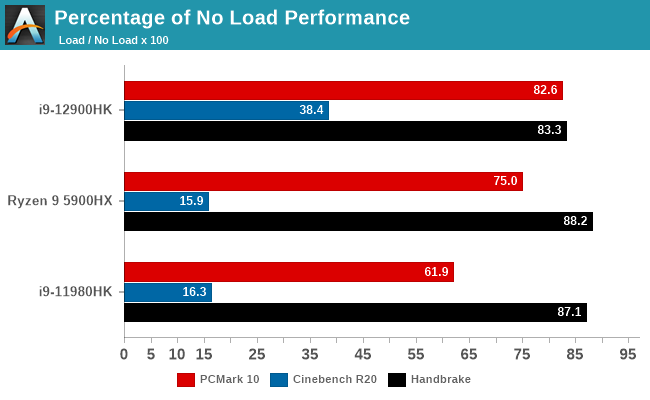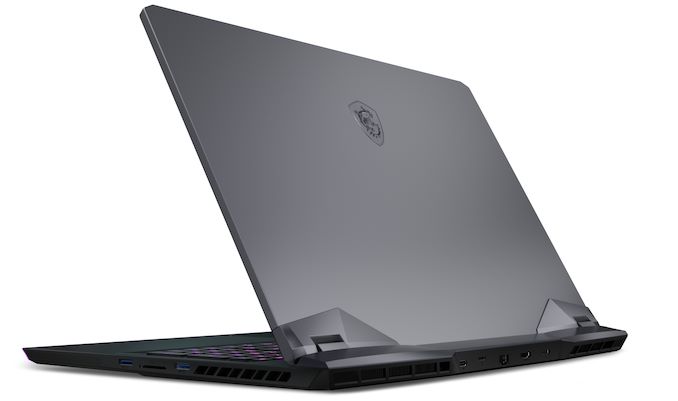Intel Alder Lake-H Core i9-12900HK Review: MSI's Raider GE76 Goes Hybrid
by Brett Howse on January 25, 2022 9:00 AM EST- Posted in
- CPUs
- Intel
- MSI
- Laptops
- Alder Lake
- GE76 Raider
- 12th Gen Core
- Alder Lake-H
Initial Thoughts
Intel has been consistent over the last several years to bring their low-power processors to market first, and then move towards the higher-performance platforms and desktops. With the laptop market being the majority of sales, this has made a lot of sense, but it most certainly has left the desktop crowd at a disadvantage. With Alder Lake, Intel has flipped that around completely by launching the desktop products first, and are now just moving down to high-performance laptops, and then finally low-power notebooks. The Core i9-12900HK at the heart of the MSI Raider GE76 is our first taste of Alder Lake in a portable system, and it tastes delicious.
The new hybrid CPU design delivers in multiple ways. Outright performance easily exceeds everything else on the market. The new Golden Cove P-Cores offer a significant uplift in terms of instructions-per-clock (IPC) and allow Intel to regain the single-thread performance crown. Having twenty threads available in a laptop processor also gives Intel the multi-threaded performance lead.
Perhaps the most impressive result though is Intel’s Thread Director, which provides very impressive system responsiveness even when the system is at 100% CPU load. Tasks that are being done in the background are still done quickly, but no longer at the expense of the user, and without having to manually adjust thread priority. This is a major win.

The supplied MSI Raider GE76 with the i9-12900HK and GeForce RTX 3080 Ti for Laptops also showcased increased gaming performance, although the increases were more subtle than the system performance results. At 1920x1080, the Alder Lake system almost universally provided a reasonable uptick in gaming performance, although the 3080L Ti GPU did not significantly move the yardstick at UHD resolutions.
Intel has also been able to integrate the CPU and chipset into one package for the 12th generation H-Series processors, and that System-on-Chip provides a lot of connectivity and expansion options, as well as compatibility with four different memory choices in DDR4, DDR5, LPDDR4, and LPDDR5. There is support for four Thunderbolt 4 controllers, as well as two by four lanes of PCIe 4.0 for storage, and another eight lanes for graphics and an additional twelve lanes of PCIe 3.0. Intel now also includes Iris Xe-LP graphics in their H-Series, with the full 96 Execution Units on tap with the Core i9-12900HK.
The one downside from sampling the MSI Raider GE76 was that it's a laptop designed to show off Alder Lake at its best with regards to performance, but at the expense of more mobile-friendly matters such as portability, energy efficiency, and battery life. Case in point: despite having the largest possible battery allowed in a notebook at 99.9 Wh, the base system power draw of the Raider was significant, making battery life poor and masking any changes that would have been a result of the CPU. Intel is aiming Alder Lake-H at everything from luggable desktop replacements such as the Raider to 14-inch ultraportable laptops, so there is a second side to Alder Lake that we've still yet to see. Once more laptops start shipping – especially the U-Series with LPDDR5 – we should get a much better feel for how the hybrid CPU design does when the device is running off the battery.
Thankfully, the lack of battery life was really the only negative for the MSI Raider GE76. It offers plenty of cooling, a great display, and offers the most potent laptop GPU on the market. The Tiger Lake version was the quickest laptop we had tested, but the new Alder Lake one takes things to another level. It is simply one of the best gaming notebooks on the market right now, and it's easy to see why Intel picked this laptop to show off the performance capabilities of Alder Lake-H.
Alder Lake appears to be a significant step forward for Intel, with commanding single-threaded performance, exceptional multi-threaded performance, and the benefits of Thread Director to increase system responsiveness. Alder Lake was a step forward for desktops, but likely an even larger step forward for notebook computers. Intel has delivered tremendous performance across the board and the gap is not even close. 2022 is shaping up to be an exciting year again.












153 Comments
View All Comments
lmcd - Wednesday, January 26, 2022 - link
Ryzen 6000 does not exist as of 1/26/2022.Your analogy is awful but ironically correct -- comparable European/Japanese sports cars also get horrifying mileage, and the performance gap is in the nonsense territory with fanboys on either side debating what the immeasurable differences mean.
Spunjji - Thursday, January 27, 2022 - link
👆PeachNCream - Friday, January 28, 2022 - link
Its always funny to watch people.try to compare computers to cars. That literally happens all of the time in the tech industry and rarely fits the situation because, well obviously, computers are not cars.TheinsanegamerN - Friday, January 28, 2022 - link
It's always funny to watch people complain about car comparisons simply because "well cars and computers are different" without any other context. Tells me you have no real counterargument.cowymtber - Tuesday, January 25, 2022 - link
Tim from HUB...Do your power normalization magic, and release the demons!Timoo - Tuesday, January 25, 2022 - link
I haven't really seen the comment floating around yet.SInce Intel got bumped by Apple, could this design be their result out of a failed collaboration?
I mean, they planned to bring this design, say, 3 to 5 years ago, for Apple MacBooks etc.
But Apple -meanwhile- was thinking they could do better by themselves?
So, now Intel had their Big.Little design, in co-op with Apple, and nowhere to go but to the x86 market in full-force. Not backed by the idea that they would also end up in the Apple store...
Brett Howse - Tuesday, January 25, 2022 - link
Not likely. Apple is a big customer, but not Intel's biggest.Timoo - Tuesday, January 25, 2022 - link
Ok, I just found it kind of "coincidential" that a year after we got the news Apple has dumped Intel for their own M1, Intel comes with a "similar" design. Which must have been in development already since -say- 2016 or 2017.Maybe I have to search it in the area of thinking along with the ARM train, where Big.Little is normal, and Intel realising they have Big.Little for x86 laying around (Atom + Core). I just got the impression that it was Apple who might have triggered this idea with Intel...
But then again; that would bring a lot of Queensize Drama to this release (the failed Intel-Apple chip). And I love drama. So I am biased, presumably :-D
Thanks for your reply!
IntelUser2000 - Wednesday, January 26, 2022 - link
No, the hybrid combo was first presented by Intel back in 2005 or so by then-CTO Justin Rattner.https://images.anandtech.com/reviews/tradeshows/ID...
It might have been first at Intel if they didn't have a braindead management and CEO and executed on 10nm.
lmcd - Wednesday, January 26, 2022 - link
Intel probably started work closer to 2012. The roadmap for Atom has been converging toward serving as a desktop/laptop small core since the smartphone Atoms got canned and tablet got deprioritized. By no coincidence, that happened when Apple slammed every smartphone chip with the A7, which was also Intel's public wakeup that Apple could easily reach laptop performance on a quick timeline.